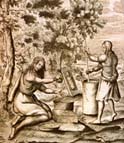

Iroquois woman grinding maize or dried berries, 1664
(engraving by unidentified engraver)
enlarge
Most of the economic activities performed by the Illinois were divided on the basis of sex. Men were responsible for hunting bison, deer and other animals. They also went on trading expeditions, defended their villages against attackers, and captured slaves during raids on other tribes. Men generally assumed most of the important leadership and religious roles in society, including the positions of peace chief, war chief, and medicine man or shaman. Men also were responsible for creating and maintaining their weapons and symbols of chiefly authority, such as bows, arrows, and calumet pipes.
Illinois women performed a long list of agricultural and domestic chores that left little time for relaxation. They were responsible for cultivating and planting their fields; harvesting, processing, and storing corn and other crops; gathering wild plant foods; drying bison and deer meat for storage; gathering firewood; and preparing meals. Women also erected houses and wove the reed mats used to cover them. They made most of the domestic containers, tools, and utensils used in the village, including pottery vessels and spoons. They also cured animal hides from which they made leather robes and clothing, spun bison hair to make breechcloths and bags, and decorated moccasins with porcupine quills. In addition to all of this, women raised their children and sometimes served as village chiefs and shamans.![]()
|
|
Copyright © 2000 Illinois State Museum